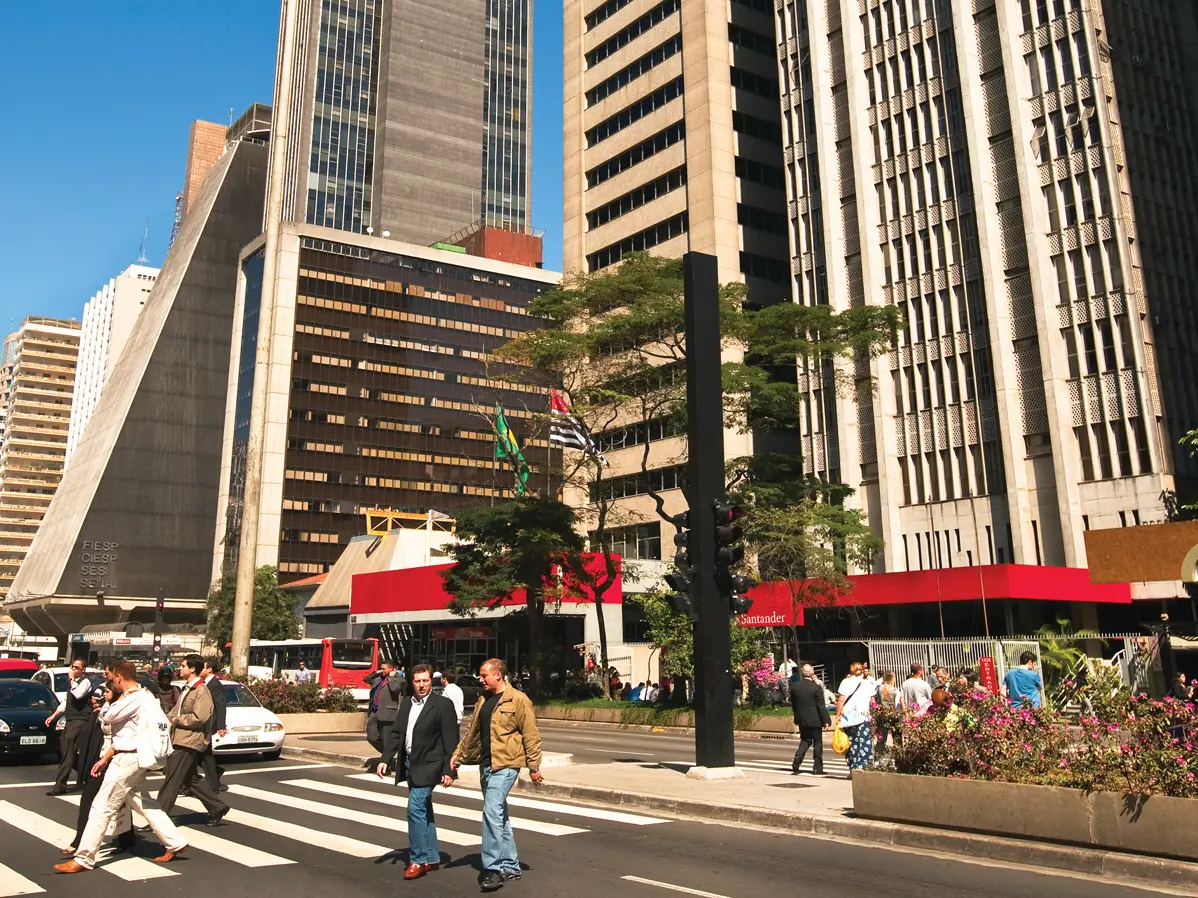Where I Live: Bustling Jakarta is ripe for adventure
Overflowing with a youthful energy, Indonesia’s capital offers things to do and places to go that will wow visiting Buckeyes. Among the can’t-miss experiences: the music and scuba scenes. But don’t take our word for it…

From left, Sandra Soetandi ’90, Daisy Kusumo Wardani ’04 and Raditio Ghifiardi ’97 visit Glodok Market, where shoppers can purchase everything from antiques to the latest tech. “The area has a mix of modern and traditional remnants,” Ghifiardi says, “and has interesting history and culture.” (Photo by Muhammad Fadli)
“Get lost.” That’s not a snub. Quite the opposite, it’s friendly advice from Jeff Sferro ’08 for visiting Jakarta, Indonesia’s capital city. “I tell people you have to go experience Jakarta, the energy of the city, and just get lost. It’s a big playground in the sense that you can go anywhere for the most part and just have an adventure.”
Allowing yourself to get lost is the way to encounter all kinds of culture, colors and people, says Sferro, who lived in Jakarta with his wife, Yuqqe Macdalena, who is Indonesian, until the start of the pandemic.
“Coming upon the traditional marketplaces and interacting with the people buying fruits or vegetables, it’s just an experience you can’t get in most places,” Sferro says.
It would appear quite easy to get lost in Jakarta: With more than 33 million residents, the urban area is the world’s second-largest and the business and cultural engine of Indonesia. The city proper is almost 60% more densely populated than New York City. Until next year, Jakarta is the seat of government. In August 2024, Nusantara — a new city 800 miles away on the island of Borneo — will become the capital, helping to ease the strain on Jakarta, located on Java.
While many people focus on the pressures on Jakarta — part of the city is actually sinking about 2 inches per year, largely due to groundwater extraction — Johnwei Muljono ’89 sees youthful energy.
“The whole country is moving very fast … to modernize a lot of things,” Muljono says, noting plans for a zero-emission new capital and a bullet train between Jakarta and Bandung, the country’s fourth-largest city. “All this is happening because of the younger generation. People want to have this, like, American Dream. We’re going to have the Indonesian Dream.”
A Jakarta business consulting firm estimates that more than 60% of Jakarta residents are under 40 years old. In a testament to this youthful demographic, Indonesia will host the FIFA U17 World Cup this this month and next.
One area of the city that demonstrates that young energy is Pantai Indah Kapuk, known as PIK, a new development in the bay area, says Imelda Fransisca ’04.
“It’s a huge development. And now I think a lot of people on the weekends just go there for cycling, running, for food, shopping, more shopping.” Fransisca also noted the area’s vibrant nightlife.
People engage in much more than shopping in Jakarta’s 130-plus malls. They are social, often luxurious, multistory centerpieces that offer a variety of entertainment.
“Malls are also a place to visit, part of the culture, mostly due to our tropical weather, hot and rainy seasons throughout the year,” Muljono says. “Most people like to chill in the malls with air conditioning.”
Fransisca, who was Miss Indonesia in 2005, lives in an apartment building attached to a mall. Other malls feature such extras as aquariums, amusement centers and arcades.
None of this is to say Jakarta doesn’t honor its past. Raditio Ghifiardi ’97 recommends tourists visit the old city, where the architecture from Dutch colonial days has been preserved. The city’s notorious vehicular traffic is limited in Jakarta Old Town, making the area more walkable. The Jakarta Marathon, held in October, runs through Old Town “so people can enjoy the scenery,” Ghifiardi says.
The National Museum of Indonesia, popularly called the Elephant Museum because of the statue out front, is in Old Town. It’s a great place to learn the history of the city, Fransisca says.
Other colonial-era buildings have been converted to restaurants. Sferro’s recommended food experiences, however, can be found all over the city.
“You could have street food vendors pushing carts, or little stands on the side of the road, or not quite restaurants but just something with a roof overhead and a little bench,” Sferro says. “This is essentially what you do together, is enjoy the food, discover what’s new and all the different tastes and varieties.”
“Even though the majority of people here are Muslim, you can still find a lot of cultural integration, in terms of their food and also the people here,” says Fransisca, who enjoys the Chinese-influenced fare in PIK.
Coffeehouses are prevalent in Jakarta and throughout the country. “The design of the shops is so fantastic,” Sferro says. “Sometimes modern, sometimes you feel like you’re in a jungle, and you can try all the different varieties of coffee beans because coffee and Indonesia are synonymous. So there are probably hundreds, if not more, varieties of beans you can try.”
Jakarta’s energetic vibe is borne out in the activities of the Indonesia Alumni Club, which won last year’s E. Gordon Gee Spirit of Ohio State Award. Muljono says club activities focus on business, education and social platforms. These platforms “allow us to be able to always connect and do something meaningful and sustainable.”

This five-story pagoda is a focal point in Pantai Indah Kapuk, known as PIK, a new development in the bay area where a lot of people go to hang out on weekends. (Photo from Getty Images)
One Buckeye’s favorite: the music scene
By Raditio Ghifiardi ’97
Jakarta’s vibrant music scene is a pulsing heartbeat that resonates throughout the city. With concerts happening almost every week, the city has become a magnet for music lovers and tourists alike. From intimate jazz clubs to grand concert halls, Jakarta’s music offerings are as diverse as the city itself.
For locals, these concerts are a regular source of entertainment and connection. They create shared experiences that foster community, reflecting Jakarta’s lively spirit. Whether it’s local talents performing traditional Indonesian melodies or international superstars lighting up the stage, there’s a musical flavor for every taste.
International tourists, on the other hand, are often drawn to Jakarta’s music scene as a unique opportunity to immerse themselves in a cultural experience. These events showcase not only Indonesia’s rich musical heritage but also its ability to embrace various global genres. Jakarta’s concerts serve as a crossroad where different musical traditions meet and blend.
Personally, I find Jakarta’s commitment to hosting regular music events to be a testament to its thriving arts and culture scene. It’s not just about entertainment; it’s a reflection of the city’s openness to creativity, collaboration and the celebration of human expression. Whether you are a passionate music enthusiast or simply looking for a fun night out, Jakarta’s musical landscape offers an inviting opportunity to explore, enjoy and connect.
As someone deeply tied to Jakarta, I take pride in this lively facet of our city’s culture. It symbolizes the energetic vibe, the mixture of the old and the new, and the unbreakable rhythm that makes Jakarta an unforgettable destination.

Examples of coral that can be found snorkeling around Raja Ampat (Photo from Getty Images)
Archipelago offers a world of wonder
It might seem counterintuitive because Jakarta is such a megalopolis, but the city often is the jumping-off point for other destinations in the region. Many business travelers visiting Jakarta take the opportunity to explore the many islands in the Indonesian Archipelago.
You say Indonesia, and a traveler will say Bali. The island east of Java seemingly has something for everyone. Its famous beaches and surfing, along with its wellness scene and ancient temples, make Bali Indonesia’s most popular tourist destination. Flights from Jakarta to Bali often take less than two hours.
More natural wonders can be enjoyed at Lake Toba on the island of Sumatra. Lake Toba is the largest volcanic lake in the world and the largest of all lakes in Indonesia. Samosir, an island in the middle of the lake, is similar in size to Singapore. Two common activities for visitors are kayaking on the 450-meter-deep lake and camping — especially glamping — around its edge.
Once a small fishing village, Labuan Bajo on the island of Flores has become a tourist destination, in large part because it is the gateway to witnessing the Komodo dragon in its natural habitat. That experience is possible only in Komodo National Park, a UNESCO World Heritage Site known for its biodiversity.
Scuba enthusiasts really shouldn’t leave the archipelago without visiting Raja Ampat, a group of more than 1,500 small islands, shoals and cays on the eastern edge of Indonesia. Covering nearly 10 million acres of land and sea, Raja Ampat is home to more than 550 types of coral and more than 1,400 varieties of coral reef fish.
Catch up with Jakarta’s Buckeyes
Alumni in Indonesia love to connect with fellow grads. Email indonesiaalumni@osu.edu.



